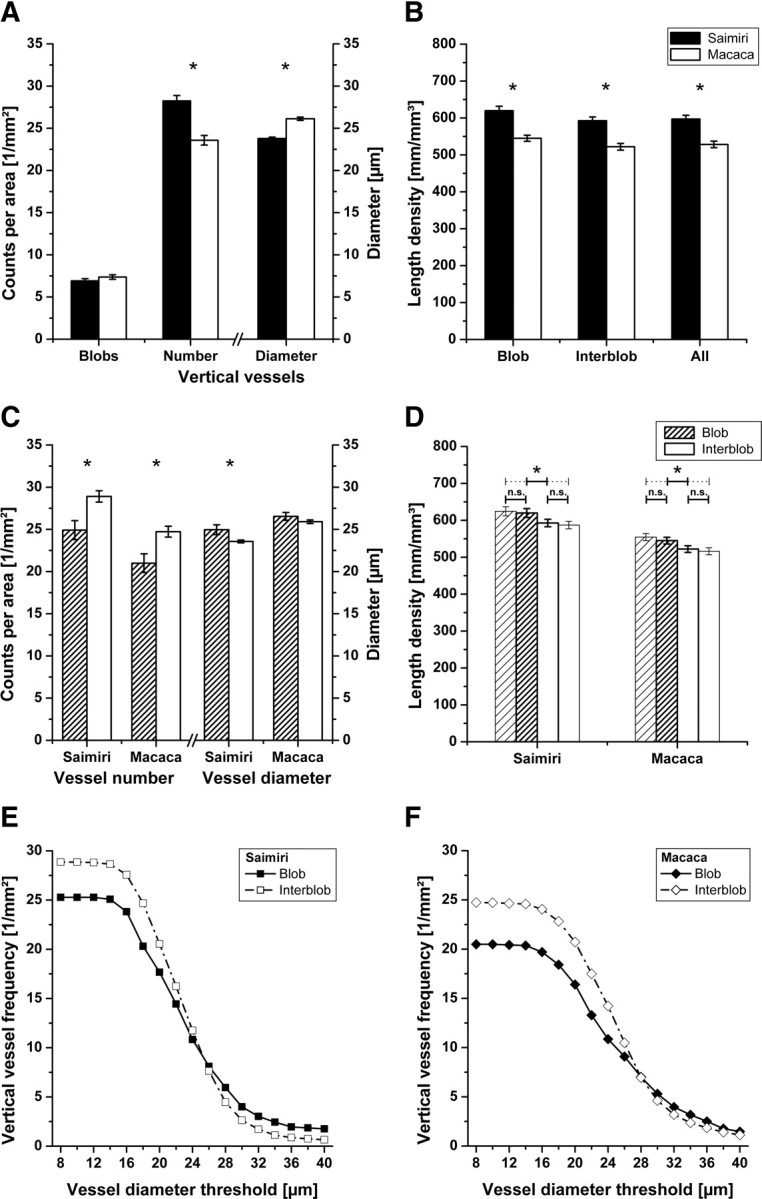Figure 4.

Top panel, Interspecies differences in numbers of blobs, numbers and diameters of perpendicular vessels, and density of vascularization. The asterisks indicate a statistically significant difference, and the error bars show SEM. A, The histogram shows counts per area (left y-axis) of blobs and vertical blood vessels and mean diameter (right y-axis) of vertical blood vessels in squirrel and macaque monkeys. The number of blobs is 8.1% higher in Macaca (difference not significant), whereas the number of perpendicular vessels is 19.5% higher in squirrel monkeys compared with macaques. The mean diameter of these vertical vessels is 9.6% greater in macaques. B, The histogram shows the vascular length density in millimeters per cubic millimeter in blobs, interblobs, and overall for the two species investigated. The length density of blood vessels in tangential sections through layer III is significantly different between squirrel and macaque monkeys in all investigated subareas, and the squirrel monkey has in general a ∼11.5% higher vascular density than the macaque. Middle panel, Numbers of perpendicular vessels and density of vascularization between blobs and interblobs in primates' V1. The asterisks indicate a statistically significant difference, and the error bars show SEM. C, The histogram shows counts per area (left y-axis) and mean diameter (right y-axis) of vertical blood vessels in blobs and interblobs of squirrel and macaque monkeys. The left half of the histogram shows the number of perpendicular vessels, and the right-hand side shows the diameters of the vessels in blobs and interblobs. In both species investigated, there are significantly more perpendicular vessels per area in the interblob areas (i.e., 16.1% more in Saimiri and 17.6% more in Macaca). The diameter of these is only a little larger within the blobs, 5.9% in Saimiri and 2.4% in Macaca. D, As shown in the histogram, the vascularization of blobs and interblobs is significantly different in both species investigated. The vascular density inside the blobs is 4.6% higher in Saimiri and 4.4% higher in Macaca compared with the interblob region. The sparsely hatched bar at far left shows vascularization in the immediate surroundings of the blobs, measured in a rim around each blob amounting to 50% of the area of the individual blob. The thinly outlined bar at far right represents vascularization in the interblob region without the surroundings. The vascularization difference between blob surround and respective interblob region is 6.3% in Saimiri and 7.4% in Macaca. Bottom panel, Cumulative curve showing the number of vertical vessels per area in blobs and interblobs in relation to the threshold diameter applied for the quantification. Note the crossing of the traces at a certain diameter value. Below this threshold there are more perpendicular vessels in the interblob regions, and above it the ratio reverses and more vertical vessels are found within blobs. E, In the squirrel monkey, the threshold diameter is 25 μm. F, In the macaque monkey, the threshold diameter is 28 μm.
